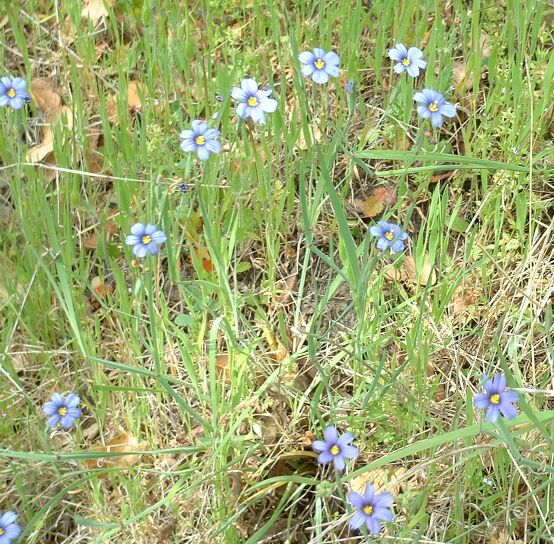- Western Blue-eyed Grass
Taxobox
name = Western blue-eyed grass

image_width = 250px
regnum =Plant ae
divisio = Magnoliophyta
classis = Liliopsida
ordo =Asparagales
familia =Iridaceae
subfamilia =Iridoideae
tribus =Sisyrinchieae
genus = "Sisyrinchium "
species = "S. bellum"
binomial = "Sisyrinchium bellum"
binomial_authority =S. Watson The Western Blue-eyed Grass or Californian Blue-eyed Grass, "Sisyrinchium bellum", is the common
blue-eyed grass ofCalifornia andOregon west of the Sierra Nevadas, its range extending south intoBaja California . It grows as aperennial plant in open places where there is some moisture, particularly grassy areas, though it can also be found in woodlands and at altitudes up to 2400 metres. Like other species of blue-eyed grasses that are locally dominant, it is generally known simply as "Blue-eyed Grass" within its natural range.The stems of the Western Blue-eyed Grass can be as long as 60 cm, though they are often shorter. Its leaves are grassy and tufted. The
flower s are 1 to 2 cm in diameter and purplish-blue, varying somewhat in color from a true blue to a definite purple; occasional white-flowering plants are found. It flowers from March to July. Dried in air, itsseed s weigh between 1 and 4 mg. After flowering, it dies to the ground and is dormant over the summer.The
Ohlone used an infusion of the roots and leaves as a cure forindigestion and stomach pain, and similar uses are recorded from other Native American peoples. Its chief modern use is as anornamental plant , and it is available for planting ingarden s. It is moderately hardy and will tolerate temperatures down to -12 degrees Celsius.In parts of its range, Western Blue-eyed Grass has previously been classified as "Sisyrinchium eastwoodiae", "S. greenei" and "S. hesperium", but these names are now considered synonyms.
Cultivation
"S. bellum" prefers some moisture and good drainage, but will tolerate summer dryness. It can be propagated by seed, and it self-sows. It can also be propagated by division of its
rhizome s, and the flower stems can be rooted.References
* [http://ucjeps.berkeley.edu/cgi-bin/get_JM_treatment.pl?Sisyrinchium+bellum Species treatment from the Jepson Manual]
* [http://elib.cs.berkeley.edu/cgi/img_query?where-genre=Plant&testing=123&rel-taxon=contains&where-taxon=Sisyrinchium+bellum&rel-namesoup=contains&where-namesoup=&where-lifeform=any&rel-location=like&where-location=&rel-country=eq&where-country=any&rel-state=eq&where-state=any&where-county=any&where-collectn=any&rel-photographer=eq&where-photographer=any&rel-kwid=equals&where-kwid= Photographs in the CalPhotos archive]
* Harlow, Nora, Jakob, Kristin, and Raiche, Roger (2003) "Wild Lilies, Irises, and Grasses". University of California Press. ISBN 0-520-23849-4.
Wikimedia Foundation. 2010.
